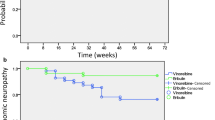Abstract
Taxane-induced neuropathy is a frequent complication, in particular in women with breast cancer. The incidence can be variable and ranges from 11 to 87%, depending on the taxane used and identified risk factors, such as cumulative dose, additional neurotoxic chemotherapy agents and previous nerve fragility. However, little is known about long-term outcome and interference with daily life activities. The objective of this study was to assess clinical and electrophysiological neurological evaluation (ENMG) in a cohort of patients, 1–13 years (median 3 years) after the end of the last cure. Sixty-nine women were enrolled in the lymphology unit of Cognacq-Jay’s Hospital. They were 58 ± 9 years old (mean age ± SD) and had been treated by docetexel (n = 56), paclitaxel (n = 10) or both (n = 3), 1–13 years before. Sensory neuropathy occurred in 64% and totally disappeared within months for only 14% after cessation of treatment. However, if symptoms were still present at the time of examination, they were considered as minor by almost all patients, with no interference with daily life activities (grade 2 CTCAE v.3.0). ENMG was accepted by 14 patients; it was normal in 7, and showed sensory axonal neuropathy in 5 and sensory-motor neuropathy in 2. The incidence of taxane-induced neuropathy is high, more frequent with paclitaxel than docetaxel, and is characterized by minor or moderate axonal sensory polyneuropathy. When persistent, it is extremely well tolerated by the patient. When clinical motor signs occur, the patient should be referred to a neurologist.
Similar content being viewed by others
References
Roglio I, Bianchi R, Camozzi F, Carozzi V, Cervellini I, Crippa D, Lauria G, Cavaletti G, Melcangi RC (2009) Docetaxel-induced peripheral neuropathy: protective effects of dihydroprogesterone and progesterone in an experimental model. J Periph Nerv Syst 14:36–44
Lipton RB, Apfel SC, Dutcher JP, Rosenberg R, Kaplan J, Berger A, Einzig AI, Wiernik P, Schaumburg HHl (1989) Taxol produces a predominantly sensory neuropathy. Neurology 39:368–373
Park SB, Lin CS, Krishnan AV, Kiernan MC, Friedlander ML, Lewis CR, Kiernan MC (2011) Early, progressive, and sustained dysfunction of sensory axons underlies paclitaxel-induced neuropathy. Muscle Nerve 43:367–374
Jones SE, Erban J, Overmoyer B, Budd GT, Hutchins L, Lower E, Laufman L, Sundaram S, Urba WJ, Pritchard KI, Mennel R, Richards D, Olsen S, Meyers ML, Ravdin PM (2005) Randomized phase III study of docetaxel compared with paclitaxel in metastatic breast cancer. J Clin Oncol 22:5542–5551
Sarosy AG, Hussain MM, Seiden MV, Fuller AF, Nikrui N, Goodman A, Minasian L, Reed E, Steinberg SM, Kohn EC (2010) Ten-year follow-up of a phase 2 study of dose-intense paclitaxel with cisplatin and cyclophosphamide as initial therapy for poor-Prognosis, advanced-stage epithelial ovarian cancer. Cancer 116:1476–1484
New PZ, Jackson CE, Rinaldi D, Burris H, Barohn RJ (1996) Peripheral neuropathy secondary to docetaxel (Taxotere). Neurology 46:108–111
Hilkens PH, Verweij J, Stoter G, Vecht CJ, Van Putten WL, Van den Bent MJ (1996) Peripheral neurotoxicity induced by docetaxel. Neurology 46:104–108
Argyriou AA, Polychronopoulos P, Koutras A, Xiros N, Petsas T, Argyriou K, Kalofonos HP, Chroni E (2007) Clinical and electrophysiological features of peripheral neuropathy induced by administration of cisplatin plus paclitaxel. Eur J Cancer Care 16:231–237
Rowinsky EK, Eisenhauer EA, Chaudhry V, Arbuck SG, Donehower RC (1993) Clinical toxicities encountered with paclitaxel (Taxol). Semin Oncol 20:1–15
Chaudhry V, Rowinsky EK, Sartorius SE, Donehower RC, Cornblath DR (1994) Peripheral neuropathy from taxol and cisplatin combination chemotherapy: clinical and electrophysiological studies. Ann Neurol 35:304–311
Lee JJ, Swain SM (2006) Peripheral Neuropathy Induced by Microtubule-Stabilizing Agents. J Clin Oncol 24:1633–1642
Hilkens PH, Pronk LC, Verweij J, Vecht CJ, van Putten WL, van den Bent MJ (1997) Peripheral neuropathy induced by combination chemotherapy of docetaxel and cisplatin. Br J Cancer 75:417–422
Martino MA, Miller E, Grendys EC Jr (2005) The administration of chemotherapy in a patient with Charcot-Marie-Tooth and ovarian cancer. Gynecol Oncol 97:710–712
Vignes S, Lebrun-Vignes B (2007) Sclerodermiform aspect of arm lymphoedema after treatment with docetaxel for breast cancer. J Eur Acad Dermatol Venereol 21:1131–1133
Nahleh Z, Pruemer J, Lafollette J, Sweany S (2010) Melatonin, a promising role in taxane-related neuropathy. Clinical Medicine Insights: Oncology 4:35–41
Hilkens PH, Verweij J, Vecht CJ, Stoter G, Van den Bent MJ (1997) Clinical characteristics of severe peripheral neuropathy induced by docetaxel (Taxotere). Ann Oncol 8:187–190
Conflicts of interest
The authors declare that they have no conflict of interest.
Author information
Authors and Affiliations
Corresponding author
Rights and permissions
About this article
Cite this article
Osmani, K., Vignes, S., Aissi, M. et al. Taxane-induced peripheral neuropathy has good long-term prognosis: a 1- to 13-year evaluation. J Neurol 259, 1936–1943 (2012). https://doi.org/10.1007/s00415-012-6442-5
Received:
Revised:
Accepted:
Published:
Issue Date:
DOI: https://doi.org/10.1007/s00415-012-6442-5




